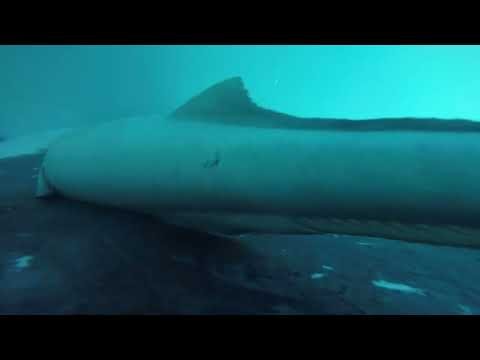Humpback whales (Megaptera novaeangliae) usually don’t travel alone. In addition to its pod, the sizable cetacean generally hosts dozens of remoras. Also known as a suckerfish, these evolutionary wonders in the Echeneidae family hitch rides on whales in order to make a meal of the sea lice and other crustaceans that also make a home on the marine mammal’s skin. To accomplish this, the remora possesses a distinctive, oval dorsal fin that functions like an adapted suction cup. The fin’s flexible membrane ridges raise and lower as needed to generate adhesive force, allowing it to either stick to the whale, or release and swim independently as needed.
Although its physical mechanics are generally understood, marine biologists know less about a remora’s day-to-day life alongside its patron whale. To glimpse this symbiotic relationship, marine biologists at Australia’s Griffith University decided to tag humpback whales with underwater cameras during their seasonal migration along the country’s eastern coast. So far, they’ve learned not just the remora’s daily habits, but the fish’s regular menu as well as how some whales view their tagalongs.

Olaf Meynecke recorded multiple videos from cameras attached to humpback whales. Credit: Griffith University
“I think one of the biggest surprises when we investigate videos captured from our tags was the remoras’ ability to move around freely and keep returning to the whale’s body, even during very fast ascents to the surface and immediately after the whale breaches and returns to the water,” marine scientist Olaf Meynecke said in a statement.
This feat even extended to occasions when a whale made a quick ascent and breached the ocean surface. Immediately after the whale went back under water, remoras were seen easily reattaching to their humpback host.
“It was amazing to see how fast and nimble they were during several different rides with the whales,” he added.
Remoras also appear to have adapted to the difficult hydrodynamics of whale travel. Technically, they don’t create a suction. Instead, their dorsal plates generate a vacuum effect allowing them to essentially adhere to the whale’s skin.
Remora species like the whale sucker (Remora australis) aren’t picky eaters either. When sea lice and other parasites aren’t around, they often will start munching on the skin shed by a whale. But despite the mutual relationship, the whales don’t appear to be the biggest fans.
“Even though they are likely beneficial for the whales, as they eat other host organisms such as sea lice, the whales seem to dislike their presence,” said Meynecke. “We have observed whales eyeing them, undertaking multiple breaches, then checking again.”
Despite this peek behind the scenes data gleaned from their whale cameras, Meynecke’s team still has a lot left to learn about the remora. For example, they still don’t know if the fish accompany whales when they travel south towards Antarctica. Then there’s the question of its overall life cycle. Remoras spawn along the East Australian Current, where small larvae grow into miniature suckerfish. These young remoras would need to find a host fast in order to survive.
“That could suggest the time of reproduction could be linked to the whales’ migration cycle,” said Meynecke.



